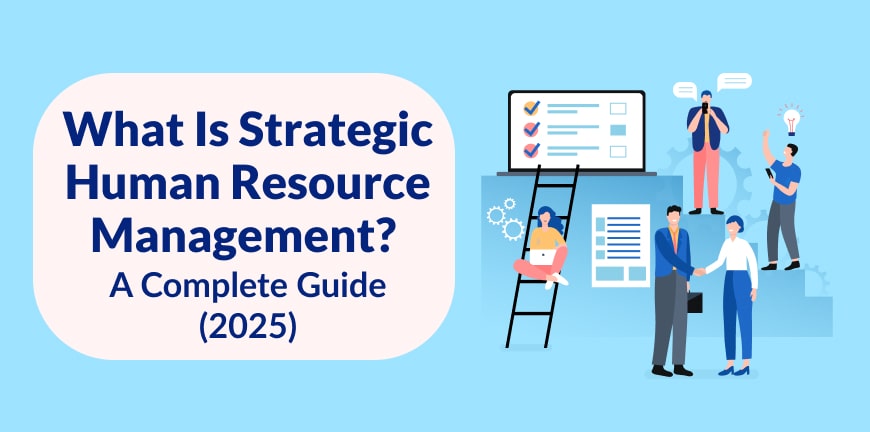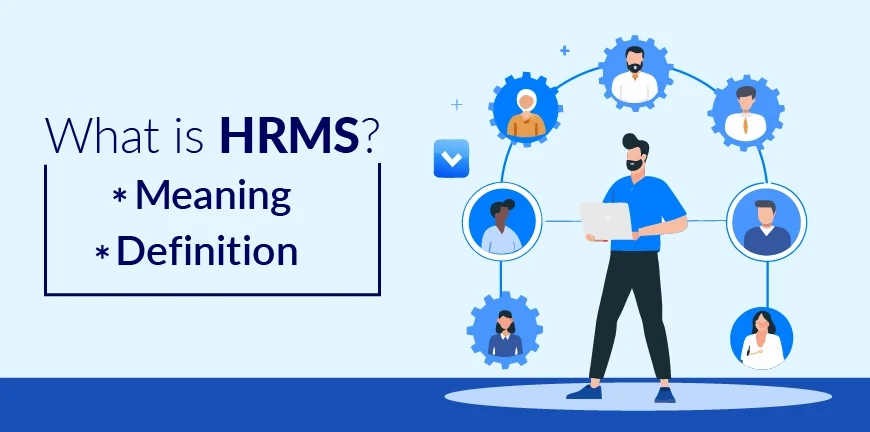
Fair Wages, Fair Workplace: Strategies for Successful Pay Equity Management
16/12/2023
What is Employee Moonlighting? Definition, Types, Examples
22/12/2023- What is IHRM (International Human Resource Management)?
- How Does International Human Resource Management Work in Multinational Organizations?
- What is the IHRM model?
- What are the objectives of IHRM (International Human Resource Management)?
- What are the Challenges of IHRM?
- What is the Difference Between International HRM and Domestic HRM?
- Future Trends in IHRM
- Best Strategies to Build a Successful Global HR Function
- What are the Functions of IHRM?
- What are the Approaches to IHRM?
- Improve your International Human Resource Management with the guidance of Alp Consulting
- Frequently Asked Questions (FAQ)
International human resource management is critical for organizations that have expanded their businesses and are present in multiple countries. But what exactly is IHRM? And how does it affect or impact the operations of multinational corporations? What are the challenges they may face?
Let us look at some vital details about IHRM.
What is IHRM (International Human Resource Management)?
The definition of international human resource management is the process of managing, training, developing, and paying employees in global organizations.
Global organizations have subsidiaries in countries outside of the home country that rely on the expertise and management capabilities of the team existing in the parent country, where the organization has its main headquarters.
International HRM concerns itself with all the HRM functions- recruitment and selection, training and development, performance management and appraisal, etc., at a global level.
How Does International Human Resource Management Work in Multinational Organizations?
To ensure effective human resource management in multinational organizations, there are certain measures taken, like ensuring the provision of diversity and inclusion measures, engaging the employees through surveys, responding to complaints and appeals from the employees, and encouraging the management of work and personal life. The role of human resource management professionals is particularly widespread and contemplates making and maintaining organizational culture.
What is the IHRM model?
The IHRM model includes activities, processes, and functions used to attract, develop, and manage the human resources of multinational companies operating across the globe.
It includes managing employees for three entities-
1. Parent country employees
Employees working in the country where the company is originally headquartered are parent country employees. For example, if an Indian is working in India for a company that originated in India and has its base here.
2. Host country employees
Employees working in the country in which the company’s subsidiary is located, for example, an Indian residing and working in another country (an NRI).
3. Third-country employees
Employees who do not belong to the parent country or host country but are employed at one of the subsidiaries or corporate headquarters, for example, a German MNC that has its corporate office in America, can employ an American as the CEO or in any other role in one of the other subsidiaries. The American is a third-country employee.

What are the objectives of IHRM (International Human Resource Management)?
Given the current business scenario, most organizations, especially ones that are financially comfortable, have gone ahead and expanded their business to other countries, establishing themselves across the globe. Now, naturally, when organizations go global, they must be aware of the laws and regulations that surround their industry in the countries where they have subsidiaries and abide by them. To understand this environment across nations is the reason why international HRM was introduced.
It is critical to study and understand the HR hiring, staffing, compensation, and appraisal process at a global level if an organization wants to effectively run its operations in other countries. The quality and skills of human resources and their effective management at an international level determine a company’s success.
International Human Resource Management comes into play when a company has subsidiaries, ventures, or activities in at least two countries other than the parent country.
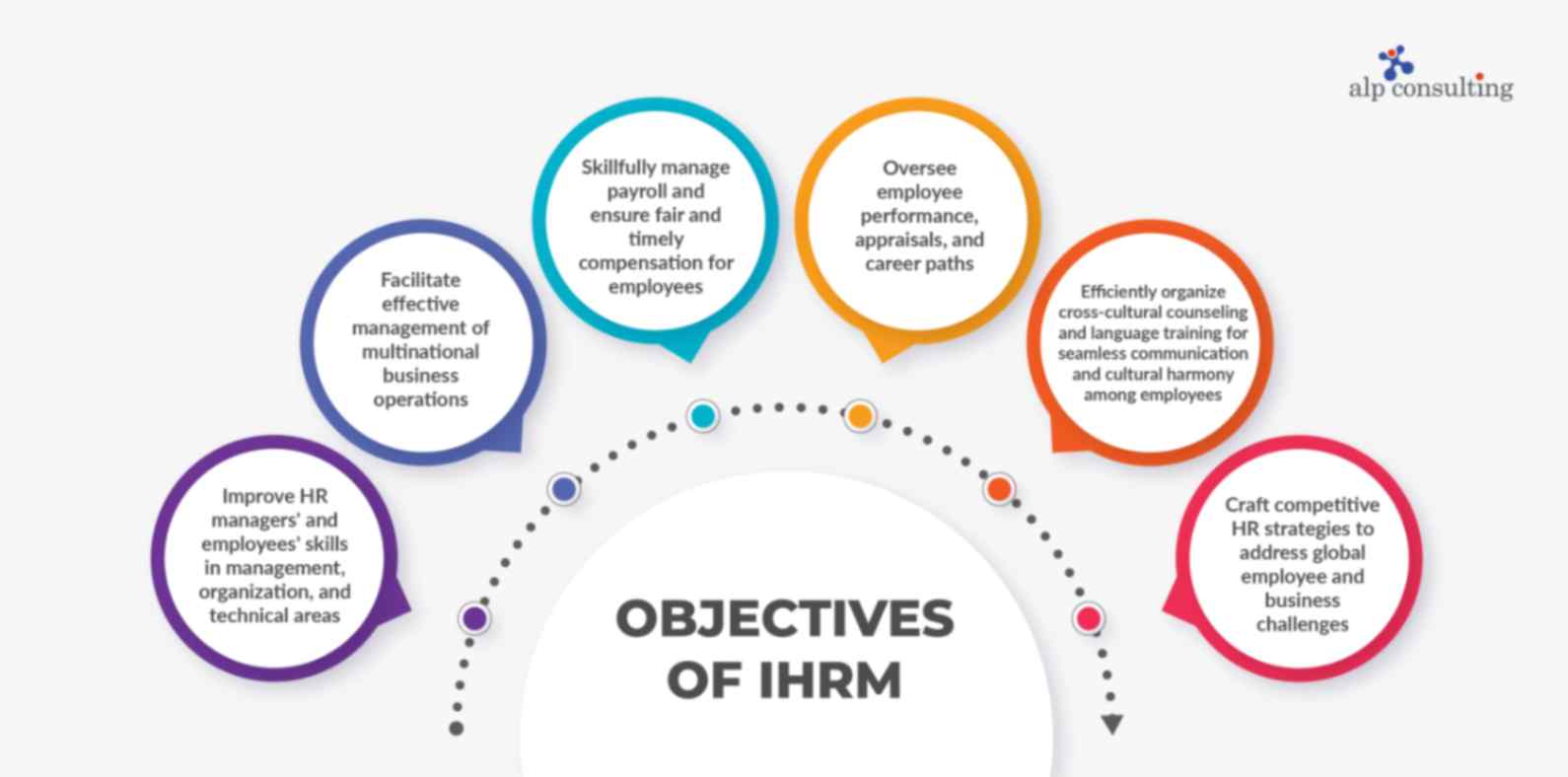
Some of the major objectives of International Human Resource Management are-
- To enhance or develop the skills, knowledge, and abilities of HR managers and employees in managerial, organizational, and technical fields.
- To help successfully develop and manage business operations spread across countries.
- To manage the payroll process and compensate employees fairly and on time skillfully and effectively.
- Manage the performances, appraisals, and career paths of employees.
- Effective management and organization of cross-cultural counselling and language training programs to help ensure seamless communication and understanding and reduce cultural differences between employees.
- Develop HR strategies that are competitive and fit to address the issues and challenges of employees and businesses in the global landscape.
What are the Challenges of IHRM?
Businesses operating on a global scale have their own pros and cons for obvious reasons. International management of human resources is not easy and is associated with many challenges. Some of the most critical challenges of International Human Resource Management are-
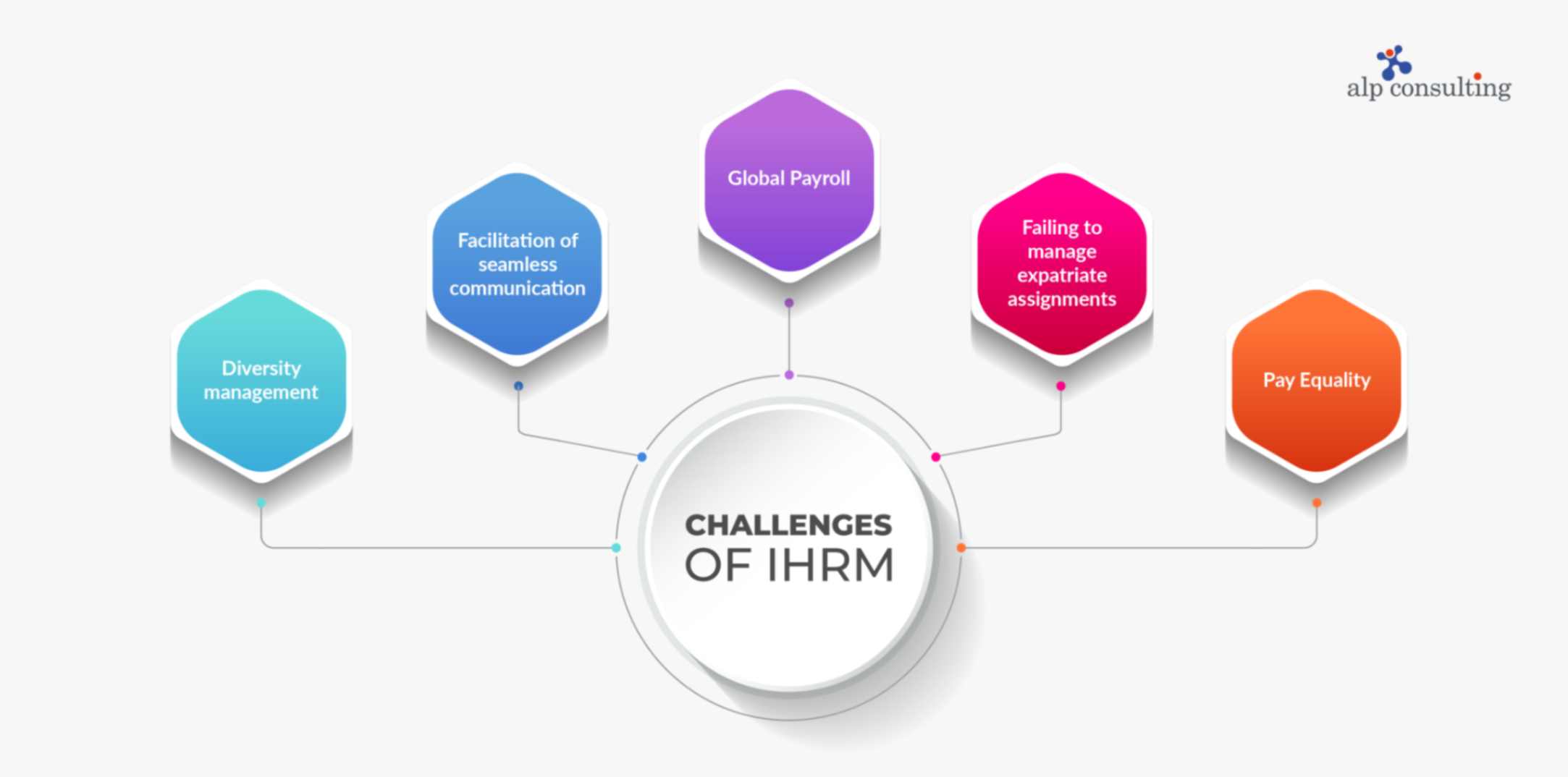
Diversity management
Managing a diverse workforce is a big challenge; internationally, it is one of the biggest challenges of IHRM. Making sure that your organization has a good balance of a diverse workforce, with high employee engagement and zero cultural differences, is one of the prime responsibilities of the IHRM team.
Facilitation of seamless communication
Internationally, it gets even more complicated to create a channel of communication between different hierarchies of employees and their heads due to geographical constraints.

Global Payroll
Payroll on a local or national level itself comes with many challenges. Managing global payroll is complicated, as there are many rules and regulations to follow to stay compliant before processing the payroll. If you are an IHRM team of an international organization looking for global payroll services, then Alp can help. Our international payroll services can help you address your challenges effectively and efficiently.
Failing to manage expatriate assignments
The role of expatriates in IHRM isn’t something that can be overlooked. Expatriate assignments are an opportunity for individuals to move to other countries for a brief period, work, and gain rich experience. For an organization, it helps in building a global network of contacts that can be useful for the company. However, sending expatriates has its own challenges.
INSEAD research found that the failure rates for expatriate assignments spanned 10-50% across industries. It was also found that those who were sent to countries with developing economies had a higher failure rate than those who went to developed countries. The reasons cited were cultural shock, depression due to isolation, and domestic issues.
Pay Equality
Gender based discrimination is present in most companies, but more so in multinational companies; the reason may vary from one company to the other. Execution of equal pay across different subsidiaries is a delicate and critical task in global human resource management.
What is the Difference Between International HRM and Domestic HRM?
| IHRM | DHRM |
| International Human Resource Management manages employees of three nation-tiers, namely the parent country nationals, host country nationals, and third-country nationals. | Domestic Human Resource Management is responsible for managing the employees of only one country, where the HRM is based. |
| Employees are spread across the globe | All the employees work within the boundaries of a single country |
| Managing international affairs is difficult and complicated, so the risks are higher for IHRM. | The risks associated with managing domestic affairs are less. |
| The IHRM must ensure that their organization’s operations align with international policies and regulations. | The external factors in DHRM are negligible in comparison. |
Future Trends in IHRM
1. AI and automation in HR
Adopting AI recruitment tools has changed the face of recruitment. Processes that previously were time-consuming and prone to errors can now be carried out with a few clicks. This includes screening resumes, scheduling interviews, etc. Additionally, tools like chatbots, by answering employee queries instantly, have increased employee satisfaction and enhanced employee experience.
2. Remote and hybrid work models
Collaboration tools, modification of workplace policies, incorporation of flexible work schedules, and implementation of performance management systems are some of the ways organizations are supporting remote and hybrid work methods.
3. Employee experience and wellbeing
Making sure employees’ mental health is good is important for organizations. Stress management programs, wellness benefits must be part of the benefits package for employees.
4. Upskilling and reskilling
Continuous learning is the only way to go if individuals want to keep their jobs and if employers want to stay competitive in this highly competitive environment. Organizations must encourage and provide opportunities to employees to upskill and reskill.
5. Globalization and diversity
Global recruitment will remain at the top of the priority list to find the best talent worldwide. Diversity and inclusion efforts are only going to help organizations bring in talent that can enhance productivity.
Best Strategies to Build a Successful Global HR Function
- Make sure your HR goals match the company’s global strategy right from the start. Also, build talent management and strategic workforce planning simultaneously while expanding your organization.
- Have a set global HR framework for policies like ethics and performance. But do leave room for making changes in terms of compensation, benefits, holidays, paid leave off etc, as required.
- Engage with expert HRM service providers like Alp Consulting, who specialise in international payroll, compliance, and benefits. This reduces risk and allows your in-house HR team to focus on strategic initiatives.
- Train employees to make them aware of cultural differences in communication, work styles, etc., to reduce misconceptions and misunderstandings among employees.
- Develop long-term recruitment networks through international platforms, partnerships, and mobility programs to secure top talent for global expansion.
- Every scripture related to your organization must have clear points. Whether it’s handbooks, onboarding materials, etc. Everything that your employees are to read must have standards. This reduces compliance issues and legal risks as well as misunderstandings.
- Make sure to know the current international laws and regulations. Conduct audits to make sure your HR procedures comply.
- The HR software you use must be of a standard so it can manage multi-currency payroll, benefits, and reporting while supporting local needs.
What are the Functions of IHRM?
The scope of IHRM involves all the functions of HRM of an organization operating at a national level, except that here, the same functions must be carried out internationally, involving employees from multiple countries. The strategies and processes involved in executing the functions vary as they must align with the goals and objectives of multinational corporations operating at a global level.
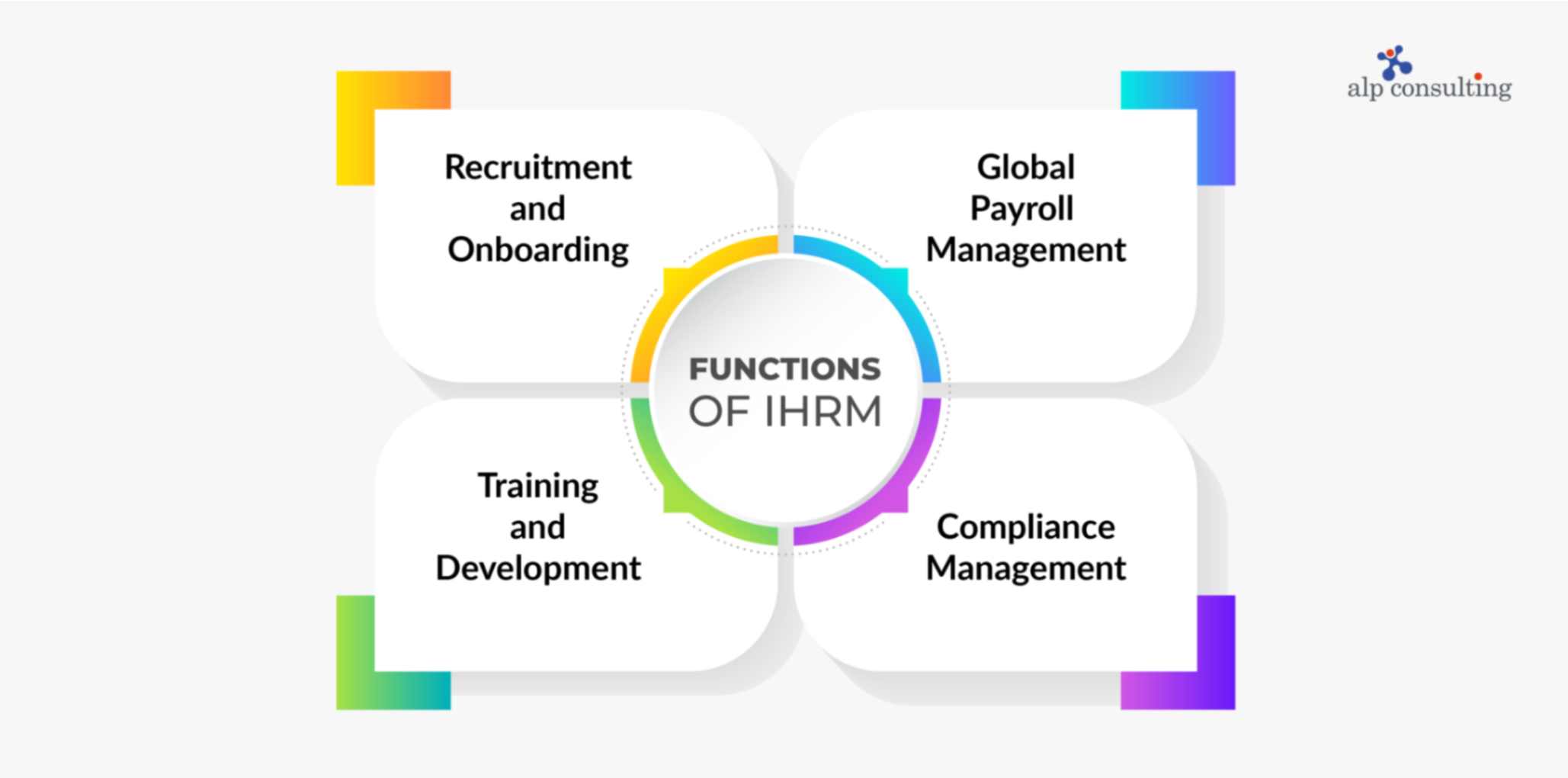
So, what are the features of IHRM?
1. Recruitment and onboarding
Recruitment and onboarding are a fundamental part of HR responsibilities. Internationally, the IHRM team must follow the same protocols, except for a few tweaks to align with international standards. As IHRM professionals, they must create job descriptions that resonate with candidates applying for roles across different countries with diverse backgrounds and cultures, interact with them, negotiate salaries, etc.
2. Global Payroll management
Payroll is the most significant function of the HR department. With global payroll, the IHRM department must be efficient at managing multi-currency payrolls. An international employee working as a host country employee must be paid in local currency. Additionally, the HR must also take care of the taxes, social security, etc., by staying compliant with the laws and regulations of the particular country the employee is working in while processing international payroll.
3. Training and Development
Initial training is necessary for every employee, no matter how skillful they are. Every organization works differently, has its own set of rules and regulations, operating procedures, etc,. which a new employee would be unaware of and must learn as they join the organization. The training methods could be online courses, webinars, seminars, etc. As part of IHRM, the team must streamline and structure the training and ensure it gets through to the employee as intended.
4. Compliance Management
Maintaining the compliance of an organization is crucial for its success. For an international organization, it’s important that it stays compliant with the regulations of different countries. The IHRM team must make sure they have all the information about different labor laws, minimum wage legislation, data protection laws, and more pertaining to other countries. The IHRM ultimately aims at helping the organization become 100% compliant and ensuring that the employees are paid on time.
What are the Approaches to IHRM?
There are different approaches to IHRM that organizations take depending on several factors that could influence their business.
Some of the major approaches of IHRM are-
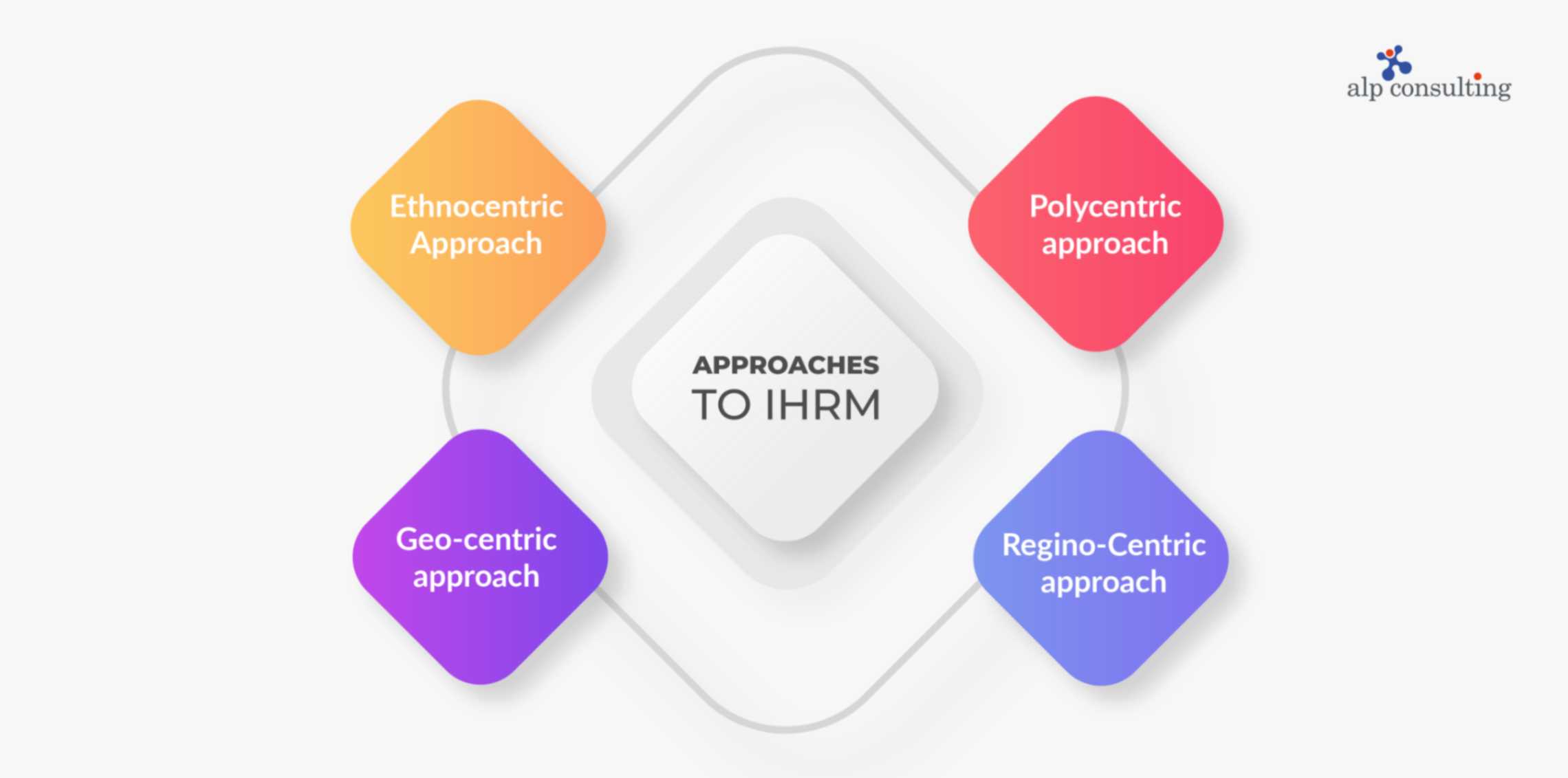
1. Ethnocentric Approach
In an ethnocentric approach, the parent company believes that its subsidiaries must adopt and follow all the procedures and policies of the parent company. Additionally, the parent company also insists on taking the lead in all the activities that happen in their subsidiaries, putting themselves in the position of major decision makers.
Most times, this results in a conflict of interest in the subsidiaries, as every country’s expectations and norms vary from one another. Maruti, Honda, etc. are live examples of this approach, and they didn’t necessarily go well and causing unrest.
While the approach may be the best for the parent country, it may not be for the subsidiaries, as every country has a different culture, way of working, attitude, and beliefs that do not necessarily align with those of the parent country.
The failure of this approach led to a modification. Nowadays, most companies adopt a polycentric or Geocentric approach to management.
2. Polycentric approach
In a polycentric approach, the parent country allows the subsidiaries to create strategies, policies, and procedures relevant to the countries they operate. It’s necessary to align the management style to suit the local culture and attitudes of the people in that country.
To help succeed in this approach, organizations recruit local people in higher management positions, along with the presence of a few parent country nationals. All operational-level policies are formed and implemented individually by the subsidiaries. Policies involving compensation, culture, and work ethics are decided locally, but ones like the values are driven from the corporate office present in the Parent Country.

3. Regino-Centric approach
While there is a difference in various aspects of culture, there are similarities too. For example, countries like India, Sri Lanka, and Japan may vary in culture and a few other aspects, but they do have a lot of similarities as well.
In a Regino-centric approach, MNCs set up regional offices to manage several countries in the region to manage as the human resources like Asia Pacific region, etc.
An upside to this approach is the innovation and creativity that can come up with due to a diverse workforce.
4. Geo-centric approach
A geo-centric approach, by far, is one of the best, most flexible approaches to IHRM. The management does not believe in geographic barriers and thinks that every country, region, or subsidiary has its own strengths, and it’s smart to go by them and make the best use of it.
These companies are considered very mature in the management process as they create flexibility for people to voice their opinions and incorporate them if seen fit.
While there may be concerns about the monitoring part, the IT-enabled integrated systems make it possible to achieve this smoothly.
Improve your International Human Resource Management with the guidance of Alp Consulting
For IHRM to be successful, you need to make sure you have the right structure and the required technology integration to enable seamless operations across countries. Alp Consulting can ensure your HR systems are well-connected across the globe. Our human resource solutions can guarantee is run through a single access point with unified workflows. We will help streamline your HR processes by using the right approach of IHRM.
Frequently Asked Questions (FAQ)
1. What is international human resource management (ihrm)?
International human resource management is the process of effectively managing the distinct activities, functions, and processes pertaining to significant HR aspects like attracting, recruitment, training, development, and payroll that are required to maintain the human resources of MNCs.
2. What is the difference between HRM and IHRM?
Domestic HRM concerns itself with the management of local/national compliance, while IHRM focuses on managing the functions, processes, and operations with international protocols in mind.
3. What are the 7Cs of international human resource management?
The 7Cs were introduced to create a framework for organizing and implementing the right set of processes internationally. The 7Cs of IHRM are- change, cosmopolitans, culture, communication, consultants, competence, and co-ordination.
4. What is the IHRM strategy?
International human resource management is also called global HR. The strategic approach involves the management of global human capital by maintaining compliance with local laws, diversity of the workforce, and coping with different employee requirements.
5. What are the main functions of IHRM?
Recruitment and onboarding, global payroll management, training and development, and compliance management are the main functions of IHRM.
6. Why is IHRM important in 2026?
International Human Resource Management (IHRM) is important in 2026 for businesses to stay competitive and resilient in a complex global market.
7. What are the challenges of IHRM?
Diversity management, facilitation of seamless communication, global payroll, failing to manage expatriate assignments and pay equality are some of the key challenges in IHRM.
Contact Us For Business Enquiry

Rajkumar Shanmugam
Rajkumar Shanmugam is the Head of HR at ALP Consulting, bringing over 19 years of comprehensive HR leadership experience across India and international markets. His expertise spans talent acquisition, employee relations, performance management, compliance, and HR transformation. Rajkumar has a proven track record of driving people-centric initiatives, enhancing workplace culture, and aligning HR strategy with business goals. With extensive experience in US staffing operations and global mobility, he continues to lead organizational excellence through innovation and employee engagement.



